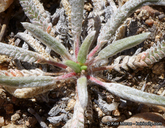Taxon Report
Ivesia argyrocoma (Rydb.) Rydb. var. argyrocomasilver-haired ivesia |
 © 2015 Keir Morse |
Taxon Summary
Ivesia argyrocoma var. argyrocoma, commonly known as silver-haired ivesia, is a perennial herb in the Rosaceae that is found only in California. It occurs within Meadows and seeps (alkaline), Pebble (Pavement) plain, and Upper montane coniferous forest, growing at elevations from 1463 to 2960 meters. Ivesia argyrocoma var. argyrocoma is ranked 1B.2, Plants Rare, Threatened or Endangered in California and Elsewhere; Moderately threatened in California.Classification
|
Scientific Name: |
Ivesia argyrocoma (Rydb.) Rydb. var. argyrocoma |
|
Common Name: |
silver-haired ivesia |
| Family: | Rosaceae |
| Element Code: | PDROS0X021 |
| USDA Plants Symbol: | |
|
Synonyms/Other Names: |
|
Ecology and Life History
| Lifeform: | perennial herb |
| Blooming Period: Jun-Aug | Jun-Aug |
| Elevation: | 1463-2960 (4800-9710) |
| General Habitats: | Meadows and seeps, Pebble (Pavement) plain, Upper montane coniferous forest |
| Microhabitat: | |
| Microhabitat Details: |
Conservation Status
| CA Rare Plant Rank: | 1B.2 |
| Global Rank: | G2T2 |
|
State Rank: |
S2 |
| State List: | None |
| Fed List: | None |
| Other Status: | SB_CalBG/RSABG; USFS_S |
|
CRPR Changes: |
|
Occurrence Data from the CNDDB
| Total Occurrences: | 41 |
| Element Occurrence Ranks: | |
| Excellent (A) | 1 |
| Good (B) | 13 |
| Fair (C) | 9 |
| Poor (D) | 2 |
| None (X) | 0 |
| Unknown (U) | 16 |
| California Endemic: True | |
| California Counties and Islands: Name (Code) | |
| San Bernardino (SBD) | |
| Quads: Name (Quad Code) | |
| Big Bear City (3411637), Big Bear Lake (3411628), Butler Peak (3411731), Catclaw Flat (3411616), Fawnskin (3411638), Harrison Mtn. (3411722), Lake Arrowhead (3411732), Moonridge (3411627), Onyx Peak (3411626) | |
Threat List Data from the CNDDB
| Threat List Total: | 13 | |
| EOs with Threat Listed: | Total EOs | % of EOs |
| 26 | 63 % | |
| ORV activity | 18 | 43% |
| Development | 12 | 29% |
| Road/trail construction/maint. | 8 | 19% |
| Foot traffic/trampling | 7 | 17% |
| Non-native plant impacts | 6 | 14% |
| Recreational use (non-ORV) | 5 | 12% |
| Wood cutting or brush clearing | 4 | 9% |
| Grazing | 4 | 9% |
| Mining | 3 | 7% |
| Non-native animal impacts | 2 | 4% |
| Other | 2 | 4% |
| Vandalism/dumping/litter | 2 | 4% |
| Altered flood/tidal/hydrologic regime | 1 | 2% |
Notes
| Threatened by development, grazing, foot traffic, mining, non-native species, recreational activities, road construction, road maintenance, and vehicles. Possibly threatened by logging. Populations in BA were determined to be taxonomically distinct and are described as I. argyrocoma var. moranii. |
|
Threats: |
|
Taxonomy: |
Citation
California Native Plant Society, Rare Plant Program. 2025. Rare Plant Inventory (online edition, v9.5.1). Website https://www.rareplants.cnps.org [accessed 14 December 2025].